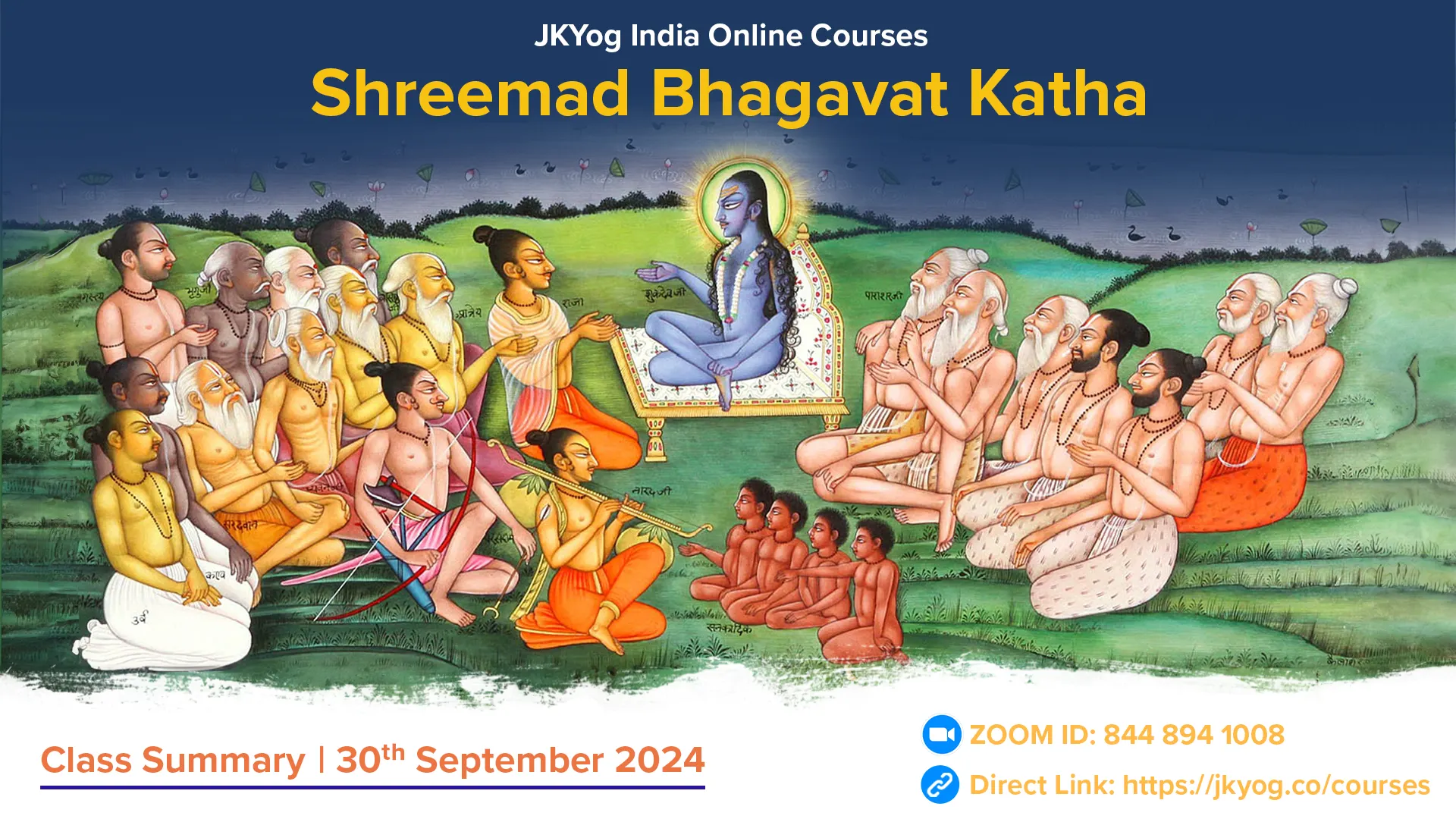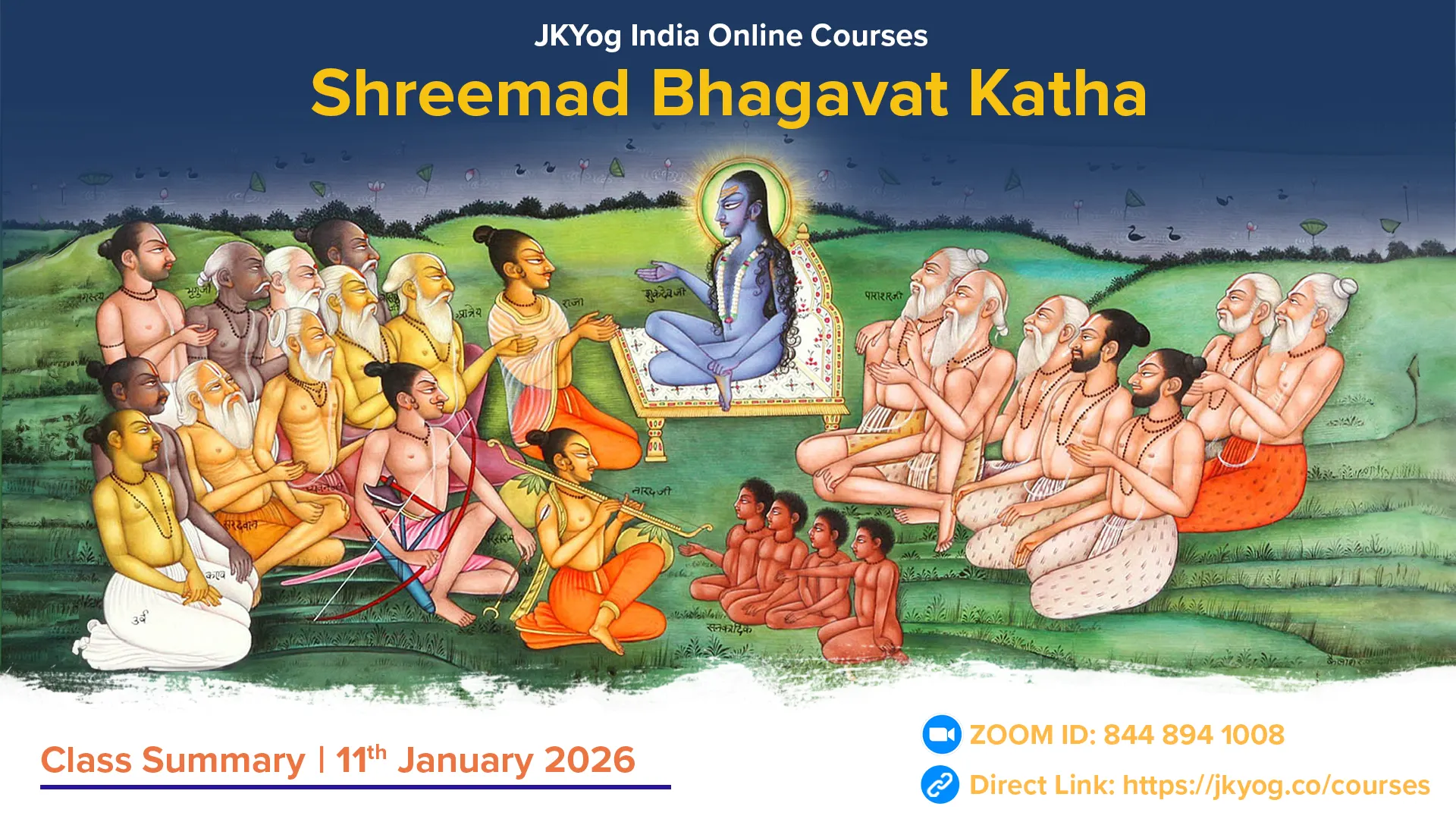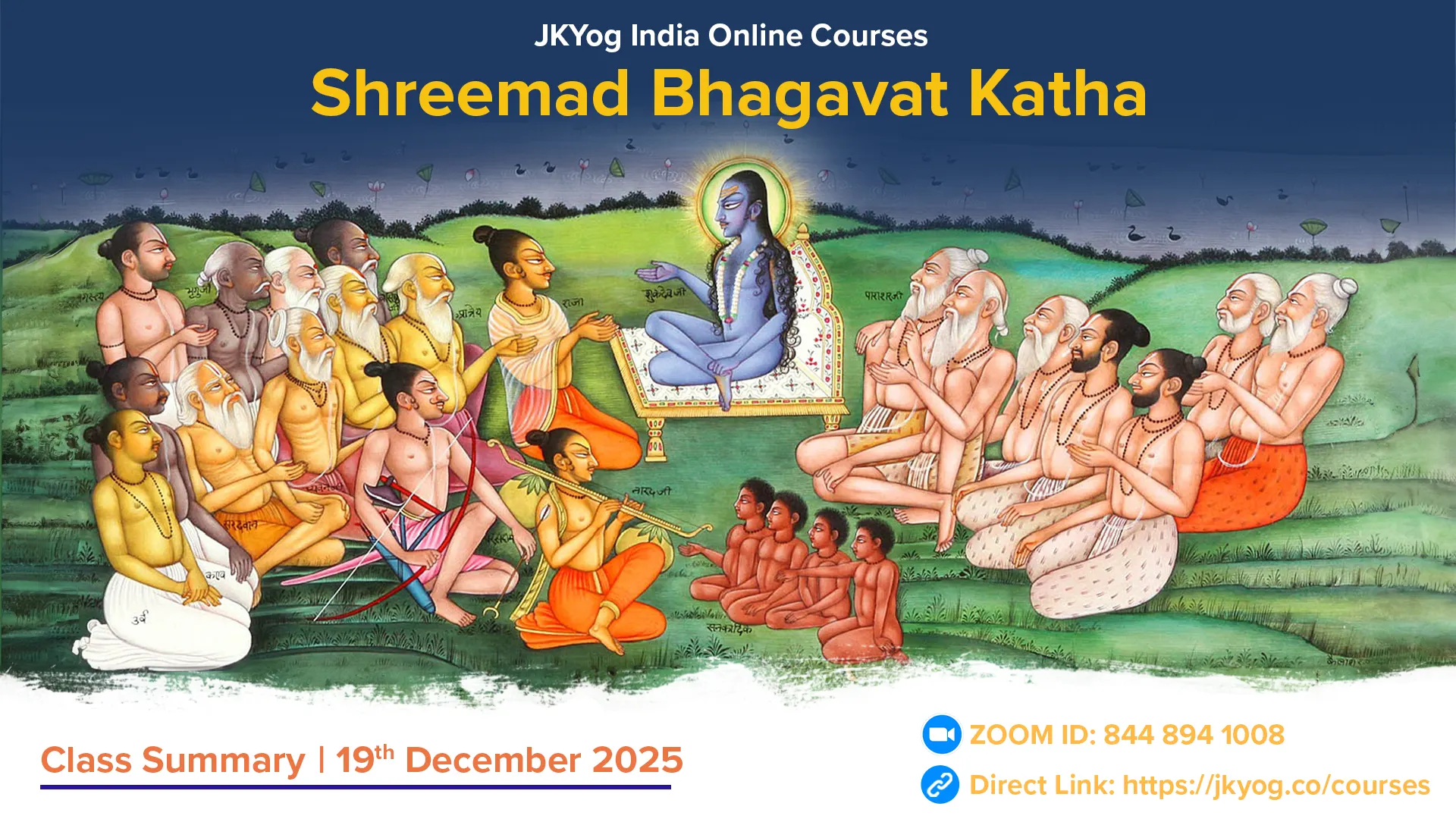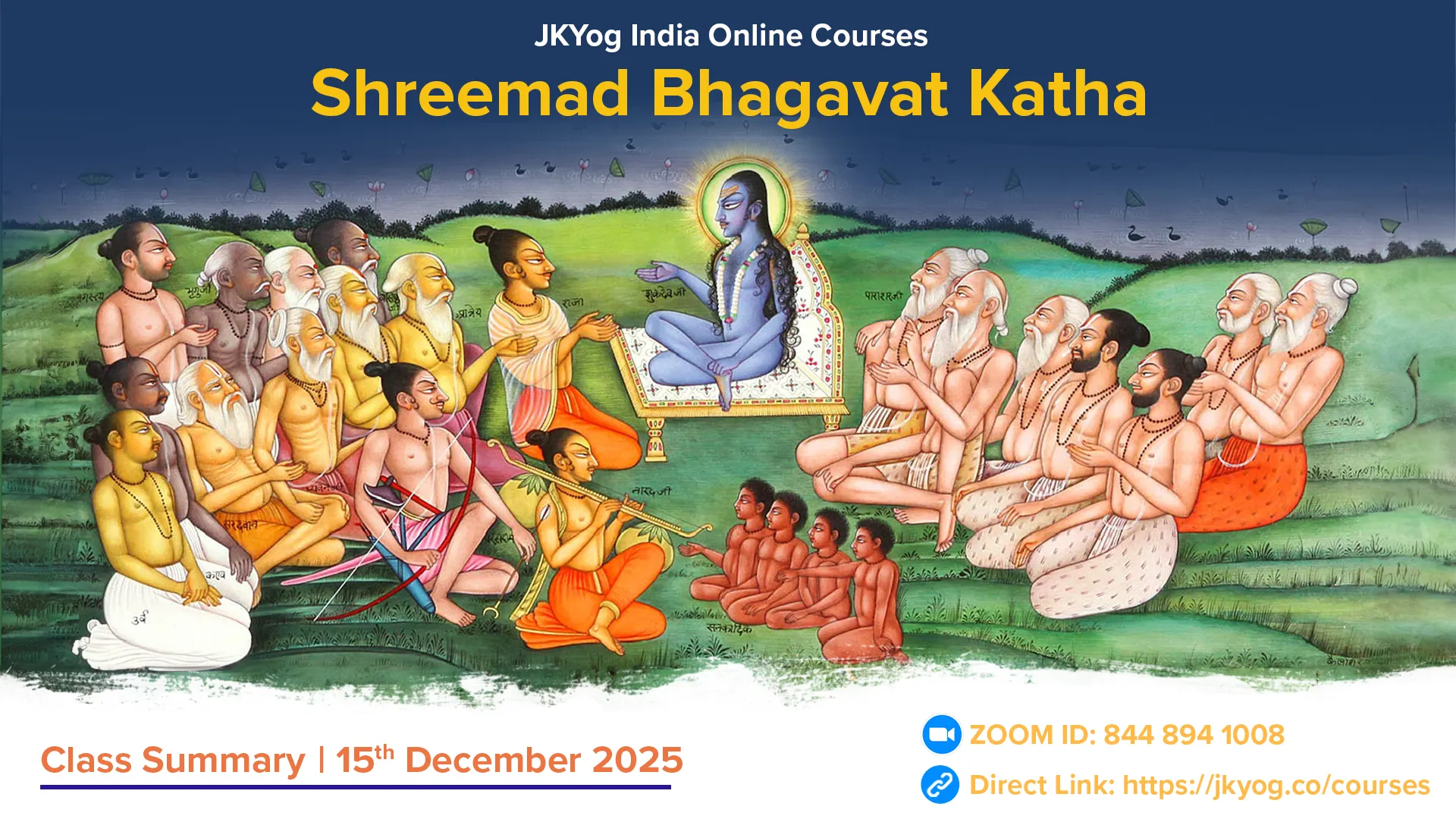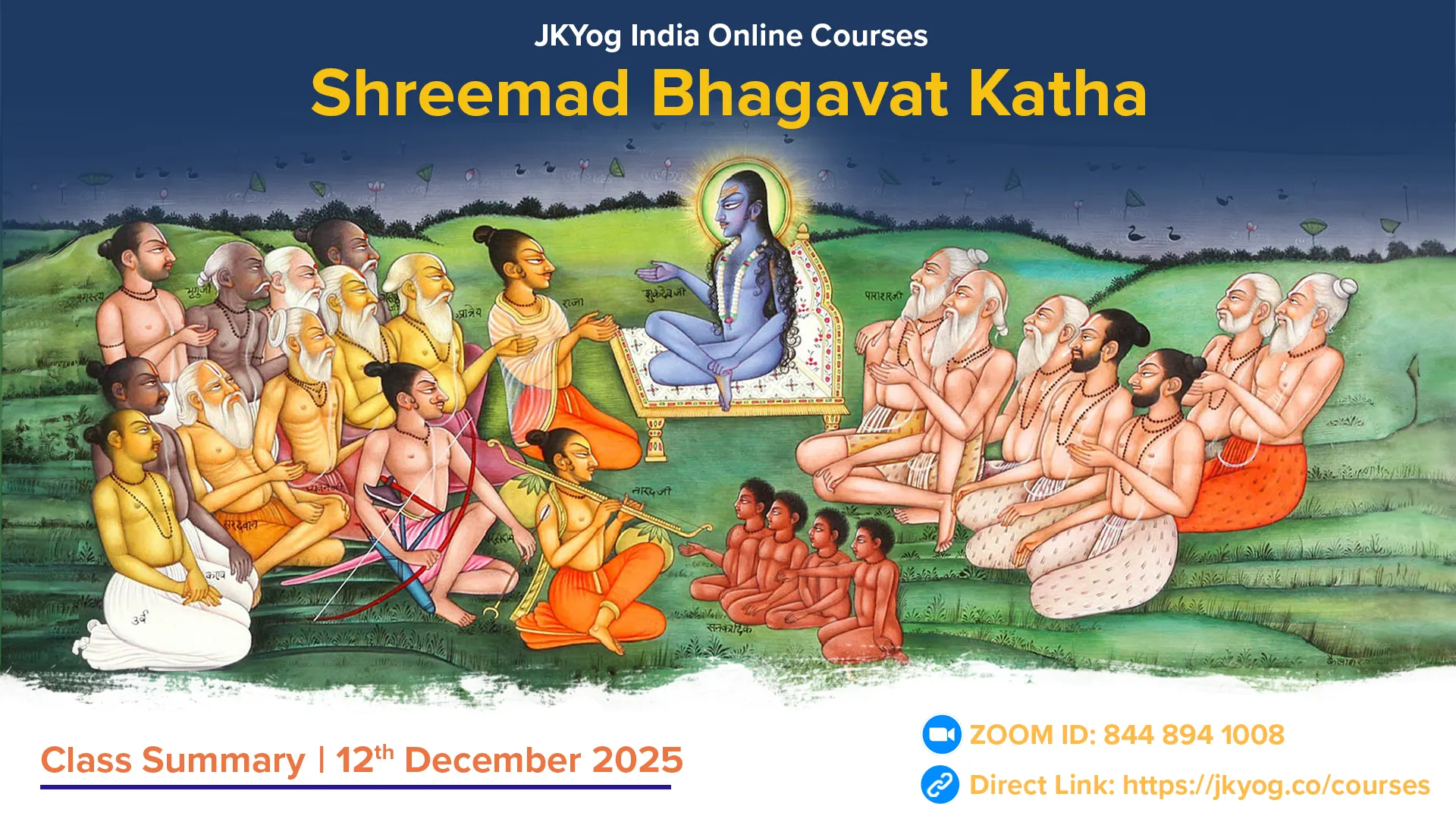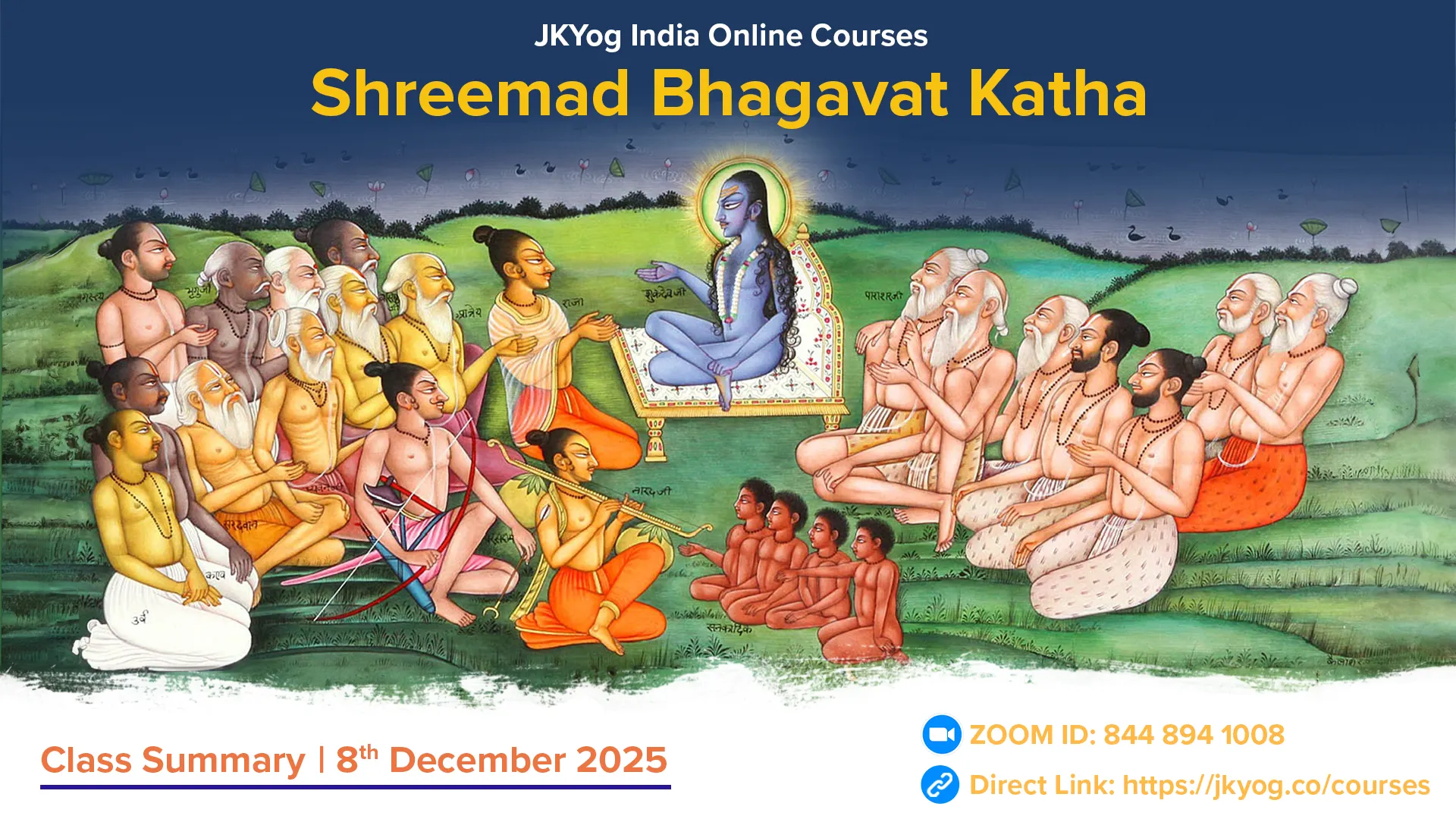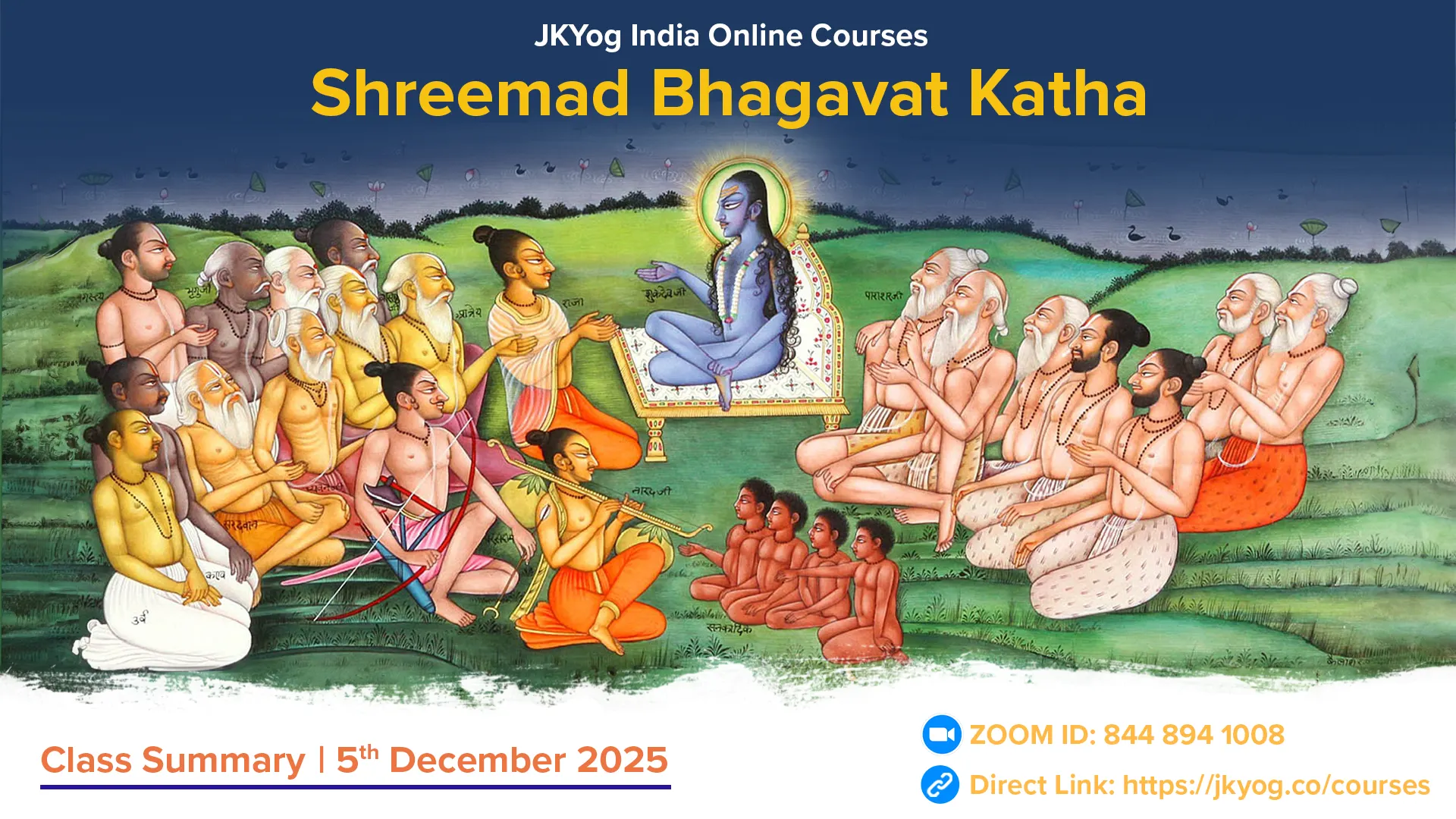Shreemad Bhagavat Mahapuran- Canto: 3, Chapters: 25 & 26
Sankhya Philosophy - Qualities of a true devotee, Prakriti and Purush, and description of the 25 tattvas.
After Kardam Muni goes to the forest, Bhagwan Kapil resides at the Bindusar Tirth to satisfy His mother, Devahuti. One day, Bhagwan Kapil is sitting in meditation. At that time, remembering Brahmaji's words, Mother Devahuti says to Him, "O Prabhu! I have become deeply troubled by the desires of these senses. Due to trying to satisfy them, I have become trapped in the deep darkness of ignorance. You have come to help me cross this unbearable darkness of ignorance. You are the Supreme Being and the master of all living entities, rising like the Sun to provide vision to the blind men engulfed in the darkness of ignorance. Please now dispel this illusion. You are like the axe that cuts down the tree of worldly existence. I have come to Your shelter, seeking the knowledge of the Prakriti and Purush. You are the greatest knower of Bhagavat Dharma. I bow down to You."
Mother Devahuti's prayer is deeply sacred and leads towards liberation. Hearing it, Bhagwan Kapil silently praises her and, with a gentle smile, prepares to respond. He says, "Mother, it is my firm belief that Adhyatm Yog (the Yog that connects the soul to the Supreme Soul) is the highest means for the ultimate welfare of human beings. Through this Yog, one attains complete freedom from both sorrow and joy. Now, I will narrate to you the same Yog of the soul, which I had previously described to sages like Narad."
Chetaha khal-vasya bandhayam mukteye chaatmano matam
Guneshu saktam bandhayam ratam va punsi mukteye
The mind is considered the cause of both bondage and liberation for the soul. When it becomes attached to worldly pleasures, it leads to bondage, and when it is devoted to the Supreme Soul, it becomes the cause of liberation. (Bhagavat 3.25.15)
What happens once the mind becomes pure?
When the mind becomes pure, free from the defects caused by ego and attachment, such as lust and greed, it attains a state of equanimity beyond pleasure and pain. At this point, the soul, with a heart filled with knowledge, detachment, and devotion, perceives itself as beyond Prakriti (Maya), as the one and only, non-dual, self-luminous, subtle, indivisible, and indifferent to both joy and sorrow. It experiences Maya as powerless. For yogis, there is no auspicious path greater than devotion to Bhagwan Shree Hari to attain Him. Wise people believe that worldly attachments bind the soul, but when this attachment is directed toward saints and great souls, it becomes the path to liberation.
Qualities of a True Devotee
Titikshavaha karunikaha suhridaha sarvadehinam
Ajata-shatravaha shantaha sadhavaha sadhu-bhushanah
Mayyanan yena bhavena bhaktim kurvanti ye dridham
Matkrite tyakta-karmanah tyakta-svajana-bandhavah
Mada-ashrayaha katha mrishtaha shrinvanti kathayanti cha
Tapanti vividhah-tapa naitan madgata-chetasah
Those who are tolerant, compassionate, selflessly benevolent to all living beings, free from enmity towards anyone, peaceful, simple-hearted, and who respect virtuous souls; who have unwavering love for Me with exclusive devotion, who abandon all actions and even their close relationships for My sake, and who, being devoted to Me, listen to and sing My sacred stories while keeping their mind constantly focused on Me—such devotees are not troubled by the various afflictions of the material world. (Bhagavat 3.25.21-22-23)
- Titikshav – Tolerant
- Karunika – Compassionate
- Suhridah Sarvadehinam – True well-wisher of all living beings
- Ajatashatravah – Free from enmity towards anyone
- Shantah – Peaceful and stable-minded
- Sadhavah – Virtuous and righteous
- Sadhu-bhushana – crown jewel among the noble souls
Further qualities of a devotee:
- Ananyabhav se dridh bhakti – Firm, unwavering devotion with exclusive love
- Tyaktakarmana – Renounces all worldly actions for Bhagwan
- Tyaktasvajan-bandhava – Renounces even close relationships for Bhagwan
- Madashraya – Completely dependent on Bhagwan alone
- Katha mrishtah shrinwanti kathayanti cha – Listens to and recites the sacred stories of Bhagwan
What Happens by Associating with Sadhus?
Bhagwan Kapil continues to explain that those great souls who completely renounce all worldly attachments are the true sadhus (saints). You should desire the company of such sadhus because they help remove all faults arising from attachment. Through the association of virtuous souls, one attains the true knowledge of Bhagwan’s divine pastimes, and His stories become dear to both the heart and ears. By engaging in these divine stories, faith, love, and devotion gradually develop in a person.
When a person contemplates Bhagwan’s pastimes, devotion arises, and dispassion toward worldly and otherworldly pleasures follows. The devotee then concentrates the mind, focusing on the simple means of Bhakti Yog to control the mind through meditation. In this way, by renouncing worldly desires like sound, form, etc., and with the knowledge born of detachment, Yog, and firm devotion to Bhagwan, one can attain Bhagwan, who resides within the self, even in this very body.
Devahuti then asks:
- "What is the nature of Bhakti? And for someone like me, weak and helpless, what kind of devotion is suitable so that I can easily attain the Yog you have described?
- What is the nature of that Yog which leads to the realisation of the Truth, like an arrow that hits its target and brings one to Bhagwan?"
The Teachings of Sankhya Philosophy by Bhagwan Kapil
Understanding the heartfelt desire of His mother, from whose body He had taken birth, Bhagwan Kapilji felt an overwhelming sense of affection towards her. Moved by this love, He imparted the teachings of the scripture that explain the principles of Prakriti and other fundamental elements, known as Sānkhyā Shastra.
Devanam guna-linganam anushra-vikakarmanam
Sattva evaika-manaso vrittiha svabhaviki tu ya
Animitta bhagavati bhaktiha siddher-gariyasi
Jarayatyashu ya kosham nigirna-manalah yatha
Shree Bhagwan says: The person who completely focuses their mind on Bhagwan finds that their senses (both the organs of action and perception) naturally become inclined towards Shree Hari. This is true devotion, known as Ahaituki Bhakti (devotion without any selfish motive). This devotion is considered even greater than liberation (moksha). To illustrate this, it is said that just as the digestive fire in the stomach burns up food, similarly, this Bhakti instantly eliminates the person's karmas and sanskaras (impressions) that reside within the material body. (Bhagavat 3.25.32-33)
What devotees do not desire:
Bhagwan Kapil says that:
- His Beloved devotees, who take pleasure in serving My lotus feet, do not desire Sayujya Moksha.
- They do not yearn for the celestial wealth or enjoyment, the eight Siddhis, or even the opulence of Vaikunth.
- They do not seek material possessions such as wealth, livestock, or homes in this world or the next.
What devotees do and what do they receive:
- My devotees serve My lotus feet and always perform all their activities for My pleasure, keeping My grace upon them.
- They joyfully discuss My glories together.
- They have the opportunity to see My beautiful and benevolent forms, for which even great ascetics yearn.
- When they reach My abode, even without desiring the eight Siddhis or the opulence of Vaikunth, all these come to them naturally.
- Those devotees who worship Me with exclusive devotion, I help them cross the ocean of worldly existence, which is filled with the fear of death.
Nanyatra mad-bhagavataha pradhana-purushe-shvarat
Atmanaha sarva-bhutanam bhayam tivram nivartate
I am the Supreme Bhagwan, the master of both Prakriti and Purush and the soul of all beings. Without taking refuge in Me, no one can escape the great fear of death. (Bhagavat 3.25.41)
Out of fear of Me, the wind blows, the sun gives heat, Indra causes rain, fire burns, and even death engages in its work because of My command.
Jnana-vairagya-yuktena bhakti-yogena yoginaha
Kshemaya pada-moolam me pravi-shanti akutobhayam
The yogis, endowed with knowledge and detachment, take refuge at My lotus feet through Bhakti Yog in order to attain peace. (Bhagavat 3.25.43)
Etavan eva lokesmin pumsam niha-shreya-sodayaha
Tivrena bhakti-yogena mano mayyarpitam sthiram
In this world, the greatest attainment for a human being is that their mind becomes firmly fixed on Me through intense Bhakti Yog. (Bhagavat 3.25.44)
Characteristics of Prakriti
Bhagwan Kapil further describes the distinct characteristics of Prakriti and other elements. Bhagwan explains that the knowledge that leads to Atmadarshan (self-realisation) is the cause of a person’s liberation and the means to cut the knot of ego in the heart. While describing this knowledge, Bhagwan says:
Anadiratma purusho nirgunaha prakriteha paraha
Pratyagdhama svayamjyotiha vishvam yena samanvitam
Bhagwan Kapil explains that the Purush is that which pervades and illuminates the entire universe. This Purusha is eternal, beyond the three Gunas (qualities of nature), beyond Prakriti, self-luminous, and manifests in the Antahkaran (inner consciousness). (Bhagavat 3.26.3)
This all-pervading Purush willingly accepts Vaishnavi Maya, which is made up of the three gunas—Sattva, Rajas, and Tamas. In accordance with its qualities, Maya begins the creation of living beings. Through Maya’s power of concealment, true knowledge gets veiled, causing the Jiva (individual soul) to become deluded and forget its true nature. Instead of recognising itself as distinct from Maya, the Jiva begins to identify with Maya and falsely believes itself to be the doer of actions. This false ego of being the "doer" leads to the bondage of birth and death and creates dependence.
The root cause of the body (the instrument of action), the senses (instruments of perception), and the presiding deities of the senses is Maya itself, as understood by the wise. Though the soul is beyond Prakriti, it is considered the experiencer of happiness and sorrow because of its association with the body and mind.
Devahuti then asks Bhagwan Kapil to elaborate further on Prakriti and Purusha’s characteristics, causes, and true identity.
Prakriti and Pradhan
Yattat triguna-mavyaktam nityam sada-sadatmakam
Pradhanam prakritim prahuha avishesham visheshavat
Bhagwan says, "That which is composed of the three gunas (Sattva, Rajas, and Tamas), unmanifest, eternal and serves as both the cause and the effect, is itself without specific attributes yet serves as the foundation for all distinct characteristics. This principle is called Pradhan, also known as Prakriti." (Bhagavat 3.26.10)
- Pradhan is described as the fundamental, unmanifest, and eternal nature from which all of creation arises. It is the most subtle form of Prakriti (Maya), existing before any specific manifestation of qualities or forms.
- Pradhan can be called 'existing' in an unmanifest form because it is the source of the entire material creation. However, it is also considered 'non-existent' in the sense that it is not yet differentiated or expressed in specific forms like earth, water, fire, etc.
- This Pradhan is the underlying essence of the material world, but it remains free from any particular qualities such as colour, shape, or form. It is beyond all dualities (like heat and cold, light and darkness). When it manifests, it produces the three gunas—Sattva (balance), Rajas (activity), and Tamas (inertia)—which give rise to the diversity of the material world.
Description of the 25 Tattvas of Sankhya Philosophy
Panchabhiha pancha-bhirbrahma chaturbhir-dasha-bhistatha
Etat chatur-vimshatikam ganam pradhanikam viduha
Mahabhootani panchaiva bhurapo-agnir-marun-nabhah
Tanmatrani cha tavanti gandhadini matani me
Indriyani dasha shrotram tvag drik rasana-nasikah
Vakkarau charanau medhram payur-dasham uchyate
Mano buddhir-ahankaraha chitta-mityantarat-makam
Chaturdha lakshyate bhedo vrittya lakshana-roopaya
Etavaneva sankhyato brahmanaha sagunasya ha
Sannivesho maya prokto yaha kalaha pancha-vimshakaha
(Bhagavat 3.26.11-15)
The twenty-four elements that make up the structure of Prakriti are as follows:
- Five Mahabhuta (Great Elements):
- Earth, Water, Fire, Air, and Ether.
- Five Tanmatras (Subtle Elements):
- Smell, Taste, Form, Touch, and Sound.
- Ten Indriyas:
- Five Jnanendriyas (Senses of Knowledge):
- Ear (hearing), Skin (touch), Eye (sight), Tongue (taste), Nose (smell).
- Five Karmendriyas (Senses of Action):
- Speech (for speaking), Hands (for work), Feet (for movement), Genital Organ (for procreation), Anus (for excretion).
- Five Jnanendriyas (Senses of Knowledge):
- Four Antahkaranas (Internal Organs):
- Mind (for will and thought), Intellect (for decision-making), Consciousness (for memory and reflection), and Ego (sense of 'I').
In addition to these, Kaal is considered the twenty-fifth element, which governs and controls the functioning of all these other elements.
What is the 25th element, Kaal?
When Prakriti is in its balanced and unmanifest state, its activities begin under the inspiration of God. Kaal is that power that activates this inactive nature and governs all the processes of creation. Bhagwan Kapil says—
Antaha purusha-roopena kala-roopena yo bahiha
Samanve-tyesha sattvanam bhagavan atma-mayaya
Thus, the Supreme Being, who is present within all living beings as the essence of life through His Maya and outside as Kaal, is the twenty-fifth element. (Bhagavat 3.26.18)
When Prakriti is calm and balanced, it is stirred by the divine inspiration of the Supreme Person’s will. The Supreme Person (Bhagwan) establishes the willpower (consciousness) in His own energy (Maya), which initiates the process of creation. In this way, a movement begins in Nature, and the process of creation starts.
Summary: JKYog India Online Class- Shreemad Bhagavat Katha [Hindi]- 30.09.2024

